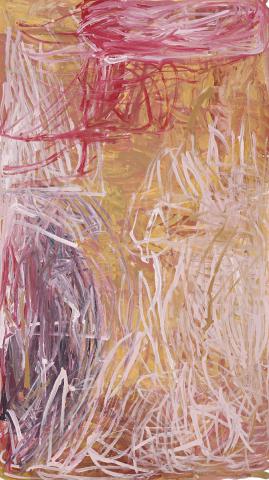MERNE - BUSH TUCKER, MY COUNTRY, 1995
EMILY KAME KNGWARREYE
synthetic polymer paint on canvas
190.5 x 107.0 cm
inscribed verso: artist's name, date and title
Rodney Gooch, Alice Springs (inscribed verso)
Utopia Art, Sydney (label attached verso)
Hugh Jamieson, Sydney
Martin Browne Fine Art, Sydney
Private collection, Sydney
Emily Kame Kngwarreye, Alhalkere, Paintings from Utopia, Queensland Art Gallery, Brisbane, 20 February – 13 April 1998; Art Gallery of New South Wales, 15 May – 19 July 1998; National Gallery of Victoria, 8 September – 22 November 1998 (label attached verso, lent by Hugh Jamieson)
A Selection of Important Twentieth Century Australian and New Zealand Paintings, Martin Browne Fine Art, Sydney, 2 – 28 June 1999, cat. 6
Utopia: The Genius of Emily Kame Kngwarreye, The National Museum of Art, Osaka, Japan, 26 February – 13 April 2008; The National Art Centre, Tokyo, Japan, 28 May – 28 July 2008; National Museum of Australia, Canberra, 22 August – 12 October 2008
Neale, M., Emily Kame Kngwarreye: Alhalkere, Paintings from Utopia, Macmillan Publishers, Melbourne, 1998, p. 127, pl. 82, cat. 77
Neale, M. (ed.), Utopia; The Genius of Emily Kame Kngwarreye, National Museum of Australia and The National Museum of Art, Osaka, 2007, p. 200, pl. G-1
In the 1990s Emily Kame Kngwarreye emerged as one of Australia's leading painters and her works became sought after on an unprecedented scale. Kngwarreye's mark making revealed a strength and sureness of hand that delivered an exuberance of gesture. Her paintings were constructed of various elements that over time were added to or eliminated from the surface of the canvas. Underlying grids structure the compositions, sequences of dots aligned between or over dots, dashes and linear marks, meandering lines and areas of dots applied on dots that allow a build up of colour. These elements constitute the artist's lexicon and are used separately or in varying combinations thus allowing her work to evolve and be constantly fresh.
This vibrant painting belongs to a group of works produced between 1995 and 1996 that were referred to by Emily as sacred grasses. This phase of her production was characterised by tangled massing of lines sometimes scrawled across the canvas. Scribbled in character, these rapid, multicoloured marks evoke the spiky angularity of desert grasses and contrast the solid meandering lines of the preceding yam paintings. Sometimes translucent in nature and at other times thick and textural, their immediacy shows a speed and energy in brushwork.
Painted for Rodney Gooch's Mulga Bore Artists, Untitled, 1995 is constructed from scribbly lines of deep reds, arctic whites, lilac, black and hot pinks that streak across the canvas randomly covering the mustard underpainting in expansive gestures only contained by the edge of the rectangular canvas.
Emily's career began in the late 1980s, and in the years until her death in 1996, she produced a body of work which radically altered the way in which we see and understand modern Aboriginal art. For most of her life she lived with little contact with the outside world. While much has been made of the way in which we might view her work in parallel with modern, non-indigenous abstraction, we must first recognize her achievement as a truly inventive and original contribution to Aboriginal art.
CRISPIN GUTTERIDGE
